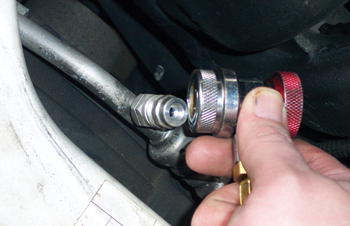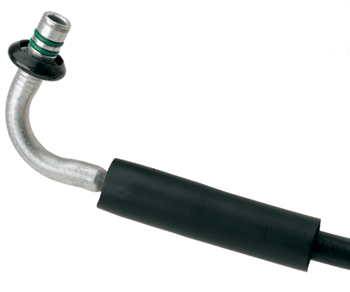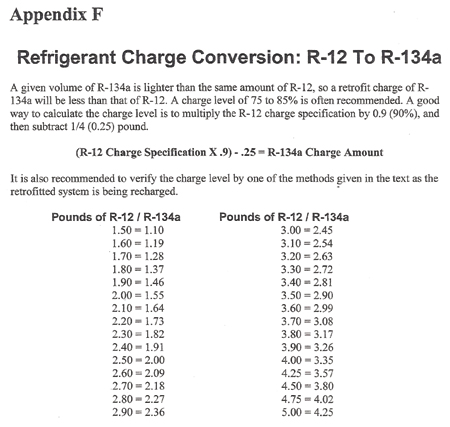s in the A/C system in good shape? Are they working, broken or leaking? Are they compatible with R-134a? After all, if the R-12 system is working, retrofitting alone will not make it better.
 Because R-12 systems were not designed to use R-134a, owners should be prepared for a slight and noticeable reduction in the A/C performance, especially in warmer climates, where the A/C systems are running for many months during the year. If this is the case at hand, the technician should recommend what additional steps are and would be most appropriate to make the retrofitting a success.
Because R-12 systems were not designed to use R-134a, owners should be prepared for a slight and noticeable reduction in the A/C performance, especially in warmer climates, where the A/C systems are running for many months during the year. If this is the case at hand, the technician should recommend what additional steps are and would be most appropriate to make the retrofitting a success.
Installing a larger condenser unit, adding an extra fan and a high-pressure cut-off switch would be the call here. But, these items will run up the expense of performing the retrofit. In addition, it may be necessary to replace any worn A/C components and some vehicles may also have components that were not made specifically to withstand the higher pressures of the R-134a refrigerant.
I still believe that there is no reason to retrofit a vehicle to R-134a as long as the R-12 system is cooling properly and holds a full charge. Any A/C system designed to use R-12 will cool best when charged with R-12 refrigerant.
If the system is leaking, repairing the leaks and recharging it with R-12 is still usually the best repair alternative. Where then does retrofitting to R-134a make the most economic sense to most customers? The answer would be, when the system requires major repairs such as a new compressor assembly, condenser or evaporator.
Yes, R-12 is no longer produced in the U.S., but supplies of recycled R-12 still can be found, often with a high price tag, depending on the supply and demand factor. This, along with the needed repairs, would drive most customers to an R-134a retrofit repair.
Although the EPA has been educating consumers about options available to them in retrofitting their A/C system, the technician or shop owner must inform the customer as to which type of retrofit procedure would work the best and what kind of price tag it would carry. The informed customer can choose an OEM-warranted retrofit, if it’s available for their vehicle, a least-costly retrofit or something in between the two. 
The OEM retrofits were designed by the manufacturer to provide the best level of performance with the new R-134a system. But, these types of retrofits would commonly come with a high cost. They would include replacement of major A/C components and must follow certain guidelines from the manufacturer and the EPA. The Society of Automotive Engineers (SAE) provides guidelines for A/C retrofits in its publication J1661.
Most of the vehicle manufacturers recommend removal of all of the mineral oil from the R-12 system. Replacement of the accumulator or the receiver-dryer with the one that contains XH-7 or XH-9 desiccant, replacing the O-rings, installing a high pressure cutout switch, changing the orifice tube or the expansion valve and then adding PAG oil before charging the system.
On some applications, they call for a more efficient condenser, which would improve cooling performance, and adding a secondary fan unit, which will provide extra cooling performance, especially at idle and low speeds.
Through conversions to R-134a to many vehicles in the past, I found R-12 to provide better heat exchange potential during times when air movement across the condenser is nominal, such as at idle or slow speeds.
For this reason, I found that replacement of the condenser unit and adding a secondary fan work quite well when retrofitting to R-134a. Also, following guidelines and federal law, a permanent installation of R-134a fittings on the high- and low-side service ports must be installed to reduce the chance of refrigerant cross-contamination, along with properly installed labels to identify that the system has been converted to R-134a.
The R-12 system then must be flushed with the approved equipment and the rubber hose lines replaced. It has been argued that it if mineral oil is left in the system it would cause system failure down the road. I’ve found that if you remove as much of the mineral oil as possible, any residual R-12 left in the system will not have a significant effect of the performance of that system. Even SAE now states that they believe that system flushing is not critical enough to affect the performance of the retrofitted system.
As far as the compressors go, some of the manufacturers have you replacing them or at the very least rebuilding them and changing out the seals and O-rings that are saturated with the R-12 refrigerant. Of course, any compressor that is not in good shape should be replaced during the retrofit procedures and service techs should make sure that the replacement compressor is approved for R-134a by its supplier.
The vehicle manufacturers still do not approve of any of the alternative refrigerants other than R-134a for retrofit. Mixing different types of refrigerants will cause problems with operating pressures for that system. System pressures will be increased, which could lead to compressor failure and loss of cooling performance down the road.
R-134a is regarded as one of the safest refrigerants introduced, based on the current toxicity data. R-134a was tested by the chemical industry’s Program for Alternative Fluorocarbon Toxicity Testing (PAFTT) and it was found that R-134a does not pose any cancer or birth defect hazards.
R-134a is not flammable at ambient temperatures and atmospheric pressures. But, it has been found that some mixtures of air and R-134a have been shown to be combustible at elevated pressures. So, R-134a equipment and A/C systems should not be pressure-tested or leak-checked with shop air.
Even though a number of refrigerants other than R-134a have been listed by the EPA as acceptable under its Significant New Alternatives Policy (SNAP) program, this program evaluates substitutes only for their effect on human health and the environment, and not for performance or durability. None of these refrigerants have been endorsed by the OEMs for use in vehicles, and most are currently not readily available in all areas of the country.
It’s important to remember that R-134a or any other alternative cannot be mixed with R-12 or used to top off the R-12 system, for this will make for system failure and very poor cooling performance problems. And one last note on R-134a refrigerant — most vehicle manufacturers will not allow any other alternative refrigerant to be used other than R-134a for their retrofits or the warranty will be voided.
As far as lubricants to be used, we know that the mineral oil used in R-12 cannot sufficiently be transported throughout the A/C system by R-134a. Automobile manufacturers have tested both PAG and esters for lubricant miscibility, chemical stability and materials compatibility.
Most choose to use PAG lubricants for their retrofits. Some of the new compressors are shipped with PAGs, some with ester and most of the ones I’ve purchased have come empty and I would have to make the determination of what I was going to use in that retrofit procedure. I recommend that you use the lubricant used by the manufacturer of the vehicle you are retrofitting.
 As far as how much to charge the system with the new R-134a, I suggest to all students and my own past technicians to charge the system 80-90% of the amount of R-12 that was needed in that system. Most A/C system manufacturers provide guidelines regarding the correct amount of R-134a to be used.
As far as how much to charge the system with the new R-134a, I suggest to all students and my own past technicians to charge the system 80-90% of the amount of R-12 that was needed in that system. Most A/C system manufacturers provide guidelines regarding the correct amount of R-134a to be used.
If no information is available, the technician can use the following math formula: multiply the R-12 charge specification by 0.9 (90%), and the subtract 1/4 (0.25) pound.
(R-12 Charge Specifications X 0.9) – 0.25 = R-134a Charge Amount). See Chart 1 that I hand out to my students, which will help them with the needed information.
Once the system is properly charged, a new sky blue-colored label that complies with the standard SAE J639 must be affixed over the existing R-12 label or if this cannot be done, then as close as possible to the R-12 label.
Any other information on the R-12 refrigerant needs to be rendered unreadable by some permanent means, such as complete removal, permanent marker or completely covered by the new R-134a label. The retrofit label shall contain the name and address of the company who performed the retrofit, the date, type and amount of refrigerant and lubricant used.
The retrofit label shall have a header with the word, “NOTICE: RETROFITTED TO R-134a.”
As you can see, there is a lot going into a good quality OEM retrofitting repair, to be followed by with a hefty repair bill to the customer who chooses this type of retrofitting procedure. Or, the customer can opt out for the “quick and easy” retrofitting procedure.
Recovering the R-12 charge, install the correct R-134a service fittings, add in lubricant needed lost from the evacuating procedure and recharge the system to 80-90% capacity with R-134a. Also, filling out and attaching the new sky-blue label with the correct information. But, these types of low-cost retrofits may not give the best cooling performance and may not even be possible on some vehicles out there.
They may also lead to customer complaints, comebacks and even more headaches for the technician/ shop owner in the future.
I’ve found that Mobile Air Conditioning Society (MACS) to provide a wealth of information on OEM retrofitting procedures and guidelines to many vehicles. I use this information to teach the new incoming technicians of tomorrow in all of my classrooms today.
Then, after all of the information is taught, I always ask my students the same question they ask me, “Is it really worth it to perform the A/C R-12 to R-134a retrofit procedure to your vehicle?” “How much are you willing to spend to achieve the best cooling A/C performance in your vehicle?” Then I let them figure out the rest.
